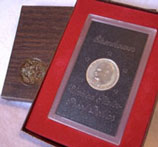
About UsThe Numismatic Bibliomania Society is a non-profit organization promoting numismatic literature. For more information please see our web site at coinbooks.org SubscriptionsThose wishing to become new E-Sylum subscribers (or wishing to Unsubscribe) can go to the following web page link MembershipThere is a membership application available on the web site Membership Application To join, print the application and return it with your check to the address printed on the application. Membership is only $15 to addresses in the U.S., $20 for First Class mail, and $25 elsewhere. For those without web access, write to: David M. Sundman, Secretary/TreasurerNumismatic Bibliomania
Society AsylumFor Asylum mailing address changes and other membership questions, contact David at this email address: dsundman@LittletonCoin.com SubmissionsTo submit items for publication in The E-Sylum, just Reply to this message, or write to the Editor at this address: whomren@coinlibrary.com
BUY THE BOOK BEFORE THE COINYou won't regret it! |
- WAYNE'S WORDS: THE E-SYLUM JANUARY 2, 2011
- NUMISMATIC LITERATURE DEALER JOHN BURNS AT 2011 F.U.N. SHOW
- REMINDER: KOLBE & FANNING NUMISMATIC BOOK AUCTION JANUARY 8. 2011
- BOOK REVIEW: MODERN FEDERAL RESERVE NOTES, 1963-2009
- PROOF AND UNCIRCULATED EISENHOWER DOLLAR ISSUE PRICES
- NOTES FROM E-SYLUM READERS: JANUARY 2, 2011
- THE PRESIDENTIAL MEDAL OF FREEDOM AND THE INSTITUTE OF HERALDRY
- MICHAEL E. MAROTTA ANNOUNCES THE EURION PROJECT
- ERIC NEWMAN ON THE PRE-HISTORY OF THE FIRST U.S. MINT
- AGUSTO CÉSAR SANDINO OF NICARAGUA, ALCHEMIST
- DICK JOHNSON: WILL 2011 BE THE YEAR WE LOSE THE CENT?
- BILL BURD: DOES MELTING CENTS MAKE SENSE?
- 2011 SUMMER ANA CALL FOR EXHIBITS
- EXHIBIT: HAND-ENGRAVED CIVIL WAR SILVER COINS
- GOLD-BASED PAYMENT SYSTEM PROPOSED IN UTAH
- THREE TONS OF SONG DYNASTY COINS FOUND IN CHINA
- BANKNOTE PAINTED ON WOMAN'S BACK FOR CHARITY FUNDRAISER
- CHOCOLATE COINS, ATTRIBUTED AND PRICE-CODED
- FEATURED WEB PAGE: AUSTRIAN CALENDAR MEDALS
WAYNE'S WORDS: THE E-SYLUM JANUARY 2, 2011

Among our new subscribers this week is Steven Franklin. Welcome aboard! We now have 1,393 email subscribers, plus 105 followers on Facebook, including Larry Downward.
Well, we've closed another year's worth of E-Sylum issues. Thanks to all of our contributors for their input - we couldn't do this every week without you. Here's looking forward to 2011.
But first, what were some of your favorite E-Sylum articles in 2010? Here's a link to the complete archive Table of Contents (be patient - it takes a while to load). Scroll through to view headlines of all articles. Click through to read an individual article.
This week we open with word from literature dealers John Burns and George Kolbe, a new review of Azpiazu's Modern Federal Reserve Notes, and reader feedback on the Mint issue price of 40% silver "Ike" dollars.
Other topics include the Presidential Medal of Freedom, the fate of the U.S. and Canadian one-cent pieces, and a new project relating to the electronic storage and processing of modern banknote images. To learn more about the Army's Institute of Heraldry, the EURion constellation, turning lead coins into gold, Alan Weinberg's Confederate and Union hand-engraved silver coins, a discovery of a three-TON coin hoard, and The Woman With a Five Pound Banknote On Her Back, read on. Have a great week, everyone!
Wayne Homren
Numismatic Bibliomania Society
NUMISMATIC LITERATURE DEALER JOHN BURNS AT 2011 F.U.N. SHOW
Numismatic literature dealer John H. Burns will be setting up at next week's F.U.N. show. He writes:
I will be at booths #101,200 at the F.U.N. show in Tampa, FL January 6-9, 2011.
REMINDER: KOLBE & FANNING NUMISMATIC BOOK AUCTION JANUARY 8. 2011
Less than a week remains before the Saturday, January 8th, 2011 Kolbe & Fanning auction of Important Numismatic Works takes place at the Waldorf Astoria Hotel in New York City. Featuring rare Russian numismatic books, an outstanding Latin American numismatic library, fabled American numismatic rarities, and other key works covering the numismatic spectrum, the sale is sure to be remembered long after 2011. Lot viewing will take place on Thursday and Friday at the American Numismatic Society headquarters in NYC and Kolbe & Fanning may be reached until Friday, January 7th, at (614) 256–8915. Live internet bidding will also be available. For details and terms please use the following direct link: www.the-saleroom.com/Catalogues/SaleDetails.aspx?eventId=2805710 .

Lot 28: Borrelly, Morton. annotated book of rubbings. London and Oslo, 1900–40. 8vo, contemporary brown half morocco with marbled boards; marbled endpapers. Approximately 160 pages, with some omissions and additions. Consists of heavily annotated pages, written in a clear hand, on which have been affixed tinted rubbings of coins from around the world. Annotations in English. A few leaves loose, but generally near fine. (350.00)
A charming volume, clearly compiled by a dedicated and knowledgeable collector. The range of material covered is impressive, as is the handwritten commentary. Morton Borrelly (about whom your cataloguer admits he has been able to discover nothing) was not only interested in all modern coins (generally 17th century and later), but seemed especially drawn to series that are frequently held to be difficult for Western collectors (Islamic, Indian, Russian, Oriental, etc.). A most interesting volume, very similar in many ways to the more famous manuscripts compiled by William H. Valentine. Ex Jan Olav Aamlid library.

Lot 271: Delgado (y Hernández), D. Antonio. nuevo método de clasificacion de las medallas autónomas de españa. tomo i, ii & iii. Sevilla: Imprenta de D. Antonio Izquierdo y García / Imp. de los Sres. A. Izquierdo y Sobrino, 1871–76. Three volumes. 4to, very handsomely bound in contemporary matching full Spanish calf; spines with four raised bands, richly decorated in gilt; two spine labels and head and tail labels of red morocco, lettered in gilt; marbled endpapers; all page edges speckled in red. (8), clxxxvii, (1), 160, (4); 394, (2); 484 (4) pages; text figures; numerous tables of alphabets...
BOOK REVIEW: MODERN FEDERAL RESERVE NOTES, 1963–2009
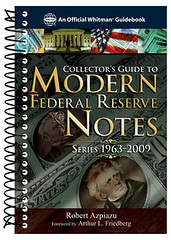 The recently released (2011), Whitman Publishing LLC, “Collector’s Guide to Modern Federal Reserve Notes, Series 1963 – 2009,” by Robert Azpiazu is another in a long line of “An Official Whitman Guidebook(s).” The reference covers 29 different series of Federal Reserve notes in denominations from $1 through $100. Star or replacement notes are also covered. It has a soft cover, is spiral bound and contains 448 well illustrated pages. It is the same size as most of the Whitman “Redbook” size references.
The recently released (2011), Whitman Publishing LLC, “Collector’s Guide to Modern Federal Reserve Notes, Series 1963 – 2009,” by Robert Azpiazu is another in a long line of “An Official Whitman Guidebook(s).” The reference covers 29 different series of Federal Reserve notes in denominations from $1 through $100. Star or replacement notes are also covered. It has a soft cover, is spiral bound and contains 448 well illustrated pages. It is the same size as most of the Whitman “Redbook” size references.
The Foreword was written by noted author Art Friedberg and he said the book is especially valuable to collectors and dealers at every level. The book lists the key notes for each denomination, which is especially useful since the number of notes printed does not always tell the whole story of what is truly scarce.
This collector’s guide to modern Federal Reserve notes is written in an easy to read and understand format. The nine page introduction contains all the preliminary information you will need if you want to start collecting these small size notes. You will learn how to differentiate between the notes printed in Washington and Fort Worth; how notes are laid out on a 32-subject sheet; the elements of Federal Reserve notes, and just what is on the face and back of each note. We recommend that you always call paper money face and back, not obverse and reverse.
The introduction also contains: The different ways to collect the notes; how to use the book; selected paper money terms; low and fancy numbers; mules, runs (there are 15 different runs in current $1 Federal Reserve Note production. A run consists of 6,400,000 notes); series and district designators and finally serial numbers.
The author has spent countless hours in researching the information for this reference. The oldest Bureau of Engraving and Printing (BEP) Report he could find was for 1976. And he went on to say that many printings were omitted or the wrong information was given for these reports. Over many years, we have seen Robert looking at auction lots and attending just about every major paper money sale held.
He also had bourse tables (or an early-bird badge), at most of the major coin and paper money shows. At these events he was constantly asking collectors and looking at dealers stocks of small size Federal Reserve Notes. Over the course of all these years of research, searching for needed information, buying and selling, he has listed prices for these notes which are a true barometer of just where the market stands for the information contained in this reference.
We collect small size Federal Reserve notes and many times we just are not sure how common or scarce a note is that we are about to purchase. With this easy to carry reference, we can look up the information with ease and know exactly what a note is worth. Though other paper money references include the pricing of the notes which are covered in this book; we feel this reference is the one to have for this series of notes.
Author Robert Azpiazu has given us a reference that will enhance the collecting of small size Federal Reserve notes. Some of the later issues of these notes can still be found in banks for face value. This reference will also be very useful from what ever source you are using to either buy or sell notes listed in the book. We have many small size FRN’s in our collection, and with this reference we can review the notes and we can determine which are common and which are scarce.
Both the dealers and collectors now have a very useful guide to price their collection or stock in a fair and equitable manner. We highly recommend this book for any numismatist or non-numismatist. Quoting Dennis Tucker, the publisher of this book for Whitman, “We feel this book has the same potential to revolutionize and invigorate paper-money variety collecting that the Cherrypickers’ Guide had for U. S. coins back in the early 1990’s.” We wholeheartedly agree and think that a steady and upward movement is in the cards for the series of notes covered in this reference.
The retail price of the reference is $29.95. For information regarding the book or purchasing a copy, you can contact: Whitman Publishing, LLC, 3101 Clairmont Road, Suite B, Atlanta, GA 30329, Phone (404) 235-5300 or (800) 546-2995, Email info@whitmanbooks.com Web Page http://whitmanbooks.com
To read Mike Marotta's review in the last E-Sylum, see: BOOK REVIEW: MODERN FEDERAL RESERVE NOTES, 1963–2009 (www.coinbooks.org/esylum_v13n52a03.html)
JANUARY 8, 2011 NEW YORK AUCTION SALE HIGHLIGHTS
Outstanding Works on Various Topics IncludingThe Prime Minister of Denmark’s Superb 1791 Beskrivelse over Danske Mynter og Medailler; Rarities on Scottish and English Numismatics from the Allan Davisson Library; the First 21 Vols. of Rivista Italiana, 1888-1908; the Firm’s Own Annotated Copies of Over 300 Glendining Catalogues, 1966-1986; Two Presentation Volumes on Canadian Numismatics by Alfred Sandham; and the Chapman’s Brothers’ Annotated 1905 Jacob Hirsch Sale of the Famed Rhousopoulos Greek Coins
141 W JOHNSTOWN ROAD, GAHANNA OH 43230-2700
(614) 414-0855 • df@numislit.com • GFK@numislit.com
PROOF AND UNCIRCULATED EISENHOWER DOLLAR ISSUE PRICES
I'm pretty sure it was $10, causing a profit that Treasury Secretary John Connolly called "unconscionable."
Don Cleveland of Australia writes:
My 1978 Coin World Almanac, page 171, says in the chronology part for 1971: "January 29 -- Treasury announces Eisenhower dollars of 40 per cent silver will sell for $10 per coin in Proof and $3 per coin in Uncirculated. Orders will be accepted beginning July 1."
I won my almanac back then in some kind of coin quiz. It's the only CWA I have and I do not know if later editions carried this information.
Heath MacAlpine writes:
The proofs went for $10 each, while the uncirculated went for $3. I have a very clear memory of ordering the 1971 proof. I was 11 going on 12, had just started my paper route so I was flush with cash ($8 a week!) and was able to indulge my growing numismatic interests by ordering the coin directly from the mint.
I remember filling out the order form, available from either the local banks or the post office, and sending it off to San Francisco. After that, the mint had me on their mailing list and sent me a high-tech computer punch card order form each year; I bought a proof each year thru 1974, but never purchased the uncirculated issues.
David Lange writes:
I'm surprised that the issue price of the silver-clad proof Eisenhower Dollars is not widely known. I'll never forget it, because the price was so outrageously high for the time. The uncirculated, or "blue-pack" Ikes priced at $3 for the four years in which it was offered, 1971-74. The proof "brown-box" edition, however, was priced at a whopping $10 for a coin that had less than $1 worth of silver. The packaging accounted for some portion of this, but the real reason for the high price was that a good chunk of the proceeds was earmarked by Congress to go to the private Eisenhower College in New York. Despite this infusion of cash, the college ultimately folded, and collectors were angry about this subsidy at their expense. It was quite a widely reported story in the numismatic press at that time.
My parents paid for my purchase in 1971 of one coin each uncirculated and proof, and I bought the subsequent editions with my own money. By 1973 the first two years' coins had begun to fall below issue price in the secondary market, and this hurt sales of the 1973-S dollars. These had noticeably lower net mintages, which led to promotional hysteria and fairly high prices for them a few years later. The 1974-S dollar benefited slightly from this promotion, as well. It was still not enough to justify continued production of the silver-clad Ikes and, after the Bicentennial Dollars dated 1776-1976, the 1977-78 coins were made solely in copper-nickel-clad.
The 1971-74 silver clad coins are not covered in my proof set book, because they were never offered as part of complete proof sets; they were marketed by the Mint solely as stand-alone items. The Bicentennial silver-clad Ikes were not sold by themselves; rather they were offered in three-coin proof or uncirculated sets which included quarters and halves of similar composition, and the proof sets are covered in my book.
To read the earlier E-Sylum article, see: QUERY: EISENHOWER PROOF DOLLAR ISSUE PRICES SOUGHT (www.coinbooks.org/esylum_v13n52a10.html)
NOTES FROM E-SYLUM READERS: JANUARY 2, 2011
Last week we quoted a Wall Street Journal article about the resignation of U.S. Mint Director Ed Moy. The article stated that under Moy's tenure the Mint "released the first U.S. coins with readable Braille characters."
Ken Berger writes:
To read the earlier E-Sylum article, see: U.S. MINT DIRECTOR ED MOY RESIGNS (www.coinbooks.org/esylum_v13n52a13.html)
Regarding last week's article titled "ASHMOLEAN MUSEUM ACQUIRES A HOARD OF ANGELS", Ken Bressett writes:
I think the proper term is a host of angels!
To read the earlier E-Sylum article, see: ASHMOLEAN MUSEUM ACQUIRES A HOARD OF ANGELS (www.coinbooks.org/esylum_v13n52a18.html)
Regarding the earliest spiral-bound numismatic book, Howard Daniel writes:
The first edition of The Catalog and Guidebook of Southeast Asian Coins & Currency, Volume I: France, by Howard A. Daniel III was published in 1975 in Reston, Virginia with comb binding. Only one hundred copies were printed and I sold them all so fast I forgot to set aside one for myself and had to buy one back at full price from a dealer who bought several copies.
At the time, my wife and I were living in an apartment on the north side of Reston, when it was a fairly new planned community, and the south side was barely developed. A new immigrant from Germany opened a print shop on the south side and needed every piece of work he could acquire so he quickly agreed to printing only 100 copies. We were both surprised with how fast it sold out, but I was soon thereafter on emergency orders to Heidelberg, Germany, so I did not have enough time to arrange another printing.
To read the earlier E-Sylum article, see: MORE ON THE EARLIEST SPIRAL BOUND NUMISMATIC BOOK (www.coinbooks.org/esylum_v13n52a05.html)
Regarding last week's Featured Web Site on Rebel States Currency suggested by John and Nancy Wilson, Larry Gaye writes:
Thanks to John and Nancy for finding this gem. An excellent source for data and comparison all in one spot.
To read the earlier E-Sylum article, see: FEATURED WEB SITE: REBEL STATES CURRENCY (www.coinbooks.org/esylum_v13n52a24.html)
THE PRESIDENTIAL MEDAL OF FREEDOM AND THE INSTITUTE OF HERALDRY
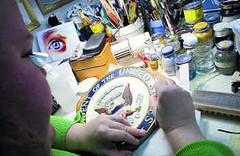 When former President George H.W. Bush visits the White House early this year, he will be one of an eclectic group that includes poet Maya Angelou , billionaire businessman Warren Buffett and German Chancellor Angela Merkel.
When former President George H.W. Bush visits the White House early this year, he will be one of an eclectic group that includes poet Maya Angelou , billionaire businessman Warren Buffett and German Chancellor Angela Merkel.
What they share is the honor of receiving the nation's highest civilian award, the Presidential Medal of Freedom.
They also have in common the object itself: a medal rooted in the Kennedy complex of Hyannis Port, Mass., with its components painstakingly kept on the Fort Belvoir Army Base. The final product is crafted, among other places, in a factory in Tomball, Texas, just outside Houston.
Its caretaker is Thomas Casciaro, who leads the technical and production division in the Army's Institute of Heraldry.
The name belies the small bungalow in which all of the medals, plaques, ribbons and other heraldic awards are designed for the executive branch, the Defense Department and other federal agencies.
Casciaro and his 22 colleagues create new designs and perform quality-control inspections, but they also serve as historians, maintaining original designs, hubs and dies, and records.
The history of the Presidential Medal of Freedom, Casciaro said, stands apart from the myriad other medals filed away in the institute's meticulous library.
Notably, the medal was a pet project of President John F. Kennedy, who recast the Medal of Freedom ordered by President Harry Truman as the Presidential Medal of Freedom, a redesign he personally oversaw.
"It's rare that a president would actually look at the design," Casciaro said, adding that he could not recall any other medal with a design that came under such high-ranking scrutiny.
Every minute specification of the design, from the thread count of the ribbon to the accompanying eagle-shaped lapel pins, is meticulously kept in the institute's records.
Documents from the time said the estimated cost for the medal's development was $5,000. To undertake a similar project today, Casciaro calculated the tab would run around $28,000.
The medals were completed in November 1963. Kennedy did not live to present them.
Presidents have since used the criteria established in Kennedy's executive order to award the medals: They are given to those to make "an especially meritorious contribution to the security or national interests of the United States, or world peace, or cultural or other significant public or private endeavors."
Given annually, it can have as many as 16 recipients and as few as one. The White House makes a bulk order every 10 years or so, purchasing 300 or 400 medals at once from one of the handful of institute-certified contractors.
That brings the Presidential Medal of Freedom to Texas. Graco Awards, a 60-employee company in Tomball, is one of the few companies authorized to make many highly restricted government medals, including the Purple Heart and the Presidential Medal of Freedom.
"It's very prestigious and it's very difficult to make," said Carol Hadley, vice president of the company. "It's very hand-labor intensive – it's a beautiful medal."
But she declined to share further details, citing proprietary information on the medal's production.
Graco and other contractors are closely watched by Casciaro and others at the heraldry institute, their products tested for metal composition, proper colors and size specifications. It is exacting, some would say finicky, work. But Casciaro said the effort is fitting of the end product.
"We're dealing with things that we're giving to what we'd classify as our nation's heroes," he said. "We take pride in that [a medal] that was made in 1960, if you make it again in 2010, it's going to be the same."
To read the complete article, see:
A small bungalow in Virginia is where the nation's biggest awards begin
(www.dallasnews.com/sharedcontent/dws/news/texassouthwest
/stories/DN-medals_02tex.ART.State.Edition1.14827bd.html)
THE BOOK BAZARRE
MICHAEL E. MAROTTA ANNOUNCES THE EURION PROJECT
 We have problems archiving modern banknotes. The central banks of thirty-one nations in conjunction with the makers of computers, software, and peripheral equipment agreed to a security protocol intended to reduce the threat of counterfeiting. Unfortunately, these barriers also prevent the legitmate work of numismatists, educators, and researchers.
We have problems archiving modern banknotes. The central banks of thirty-one nations in conjunction with the makers of computers, software, and peripheral equipment agreed to a security protocol intended to reduce the threat of counterfeiting. Unfortunately, these barriers also prevent the legitmate work of numismatists, educators, and researchers.
The Eurion Project is an effort to help numismatists and other legitimate investigators.
The name of the project comes from the "Eurion Constellation" of zeroes (also called OMRON rings) found on many modern banknotes. Originally devised to thwart reproduction of banknotes on large, automatic photocopiers, that device itself is neither necessary nor sufficient to prevent our work, but was previously thought to do so. It is still a useful name. And it indicates the benefit of open investigation, research, and reporting, as the original summary by university professor Markus Kuhn was corrected by his colleague Steven J. Murdoch a few years later.
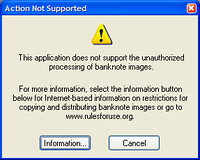 My goal is to establish a database of known hardware, software, and target banknotes, which will allow numismatists to download binary patches to re-enable the archiving, storage, transmission and reproduction of fiduciary instruments.
My goal is to establish a database of known hardware, software, and target banknotes, which will allow numismatists to download binary patches to re-enable the archiving, storage, transmission and reproduction of fiduciary instruments.
Understand that in addition to the barriers created by the banks and computer companies, US law proscribes certain actions. The US Code Title 18 Part I Chapter 25 prohibits the transmittal of the tools of counterfeiting by electronic means. Therefore, I have a contact at the Electronic Frontier Foundation, an attorney who is helping me to frame the project within the confines of the law. Those same laws also include mandates that the Secretary of the Treasury establish guidelines for the legitimate use of these media.
TITLE 18 > PART I > CHAPTER 25 > § 474(b)
"... The Secretary shall establish a system (pursuant to section 504) to ensure that the legitimate use of such electronic methods and retention of such reproductions by businesses, hobbyists, press and others shall not be unduly restricted."
TITLE 18 > PART I > CHAPTER 25 > § 504 Printing and filming of United States and foreign obligations and securities
(2) ... The Secretary shall establish a system to ensure that the legitimate use of such electronic methods and retention of such reproductions by businesses, hobbyists, press or others shall not be unduly restricted.
For now, I am only gathering information. I have no solutions to offer, no programs or binary patches. I announced this project on a couple of message boards (CoinPeople and CoinTalk) before bringing it to The E-Sylum.
On December 1 and December 8, 2010, I spoke to two local security groups in Ann Arbor. As they are not numismatists, I pointed out that several of the men who signed the Declaration of Independence also signed the paper money of their colonies and states. Former Secretary of the Treasury Lawrence H. Summers became the president of Harvard University. Andrew Mellon's name graces one of our most prestigious universities. Salmon P. Chase was a Supreme Court Justice. Signatures matter -- and they are just one detail. History is at risk.
Anyone who wants to know more can start with these sites:
The Central Bank Counterfeit Deterrence Group (CBCDG)
www.rulesforuse.org
Eurion Constellation
en.wikipedia.org/wiki/EURion_constellation
Dr. Steven J. Murdoch
www.cl.cam.ac.uk/~sjm217/
In addition to my numismatic credentials, in 2008, I earned a bachelor of science degree in criminology. My contact information is on my website, www.washtenawjustice.com .
ERIC NEWMAN ON THE PRE-HISTORY OF THE FIRST U.S. MINT
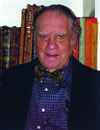 Private contractors continued to seek authorization to strike coins for the United States. English minters in 1791 struck quantities of samples of WASHINGTON PRESIDENT copper one-cent pieces and in 1792 coined an improved design to include 13 stars. Peter Getz of Lancaster, Pennsylvania, submitted 1792 half dollar–size trial coinage with a numeric presidential legend (G. WASHINGTON PRESIDENT I) in accordance with pending congressional legislation. That coinage was immediately deemed unacceptable.
Private contractors continued to seek authorization to strike coins for the United States. English minters in 1791 struck quantities of samples of WASHINGTON PRESIDENT copper one-cent pieces and in 1792 coined an improved design to include 13 stars. Peter Getz of Lancaster, Pennsylvania, submitted 1792 half dollar–size trial coinage with a numeric presidential legend (G. WASHINGTON PRESIDENT I) in accordance with pending congressional legislation. That coinage was immediately deemed unacceptable.
It was obvious that having gold and silver coinage minted in Europe was impractical because of the risk of sea transport to the United States. Copper coinage minted in England for the United States was somewhat practical because much copper was produced and refined there. When the first U.S. Mint was under construction in Philadelphia, quantities of copper were purchased from Swedish and English sources, and the U.S. Mint advertised in a Philadelphia newspaper to buy copper. An English source thereafter furnished many copper planchets for the first U.S. Mint.
In the thinking for the development and operation of a U.S. Mint, many problems had to be solved. Sufficient water power was not available in Philadelphia or New York or in a future possibility of the new federal capital along the Potomac River. The advantage of steam power was known in America from the successful Boulton & Watt private enterprise in Soho, near Birmingham, England, but the Royal Mint in London had not introduced that type of energy. Steam power in the United States was not then sufficiently developed. Therefore, the first U.S. Mint had to rely on the power of horses and the strength and physical coordination of men, which, although very burdensome, had the virtue of reliability. With mechanical skills available there, the location of choice was Philadelphia.
 Jefferson’s hope and dream came true after about 18 years of the struggle and devotion of many. The coins minted at the first U.S. Mint are evidence of its achievement. The exciting historical detail of that establishment is outstandingly presented by Leonard Augsburger and Joel Orosz in The Secret History of the First U.S. Mint: How Frank H. Stewart Destroyed—And Then Saved—A National Treasure.
Jefferson’s hope and dream came true after about 18 years of the struggle and devotion of many. The coins minted at the first U.S. Mint are evidence of its achievement. The exciting historical detail of that establishment is outstandingly presented by Leonard Augsburger and Joel Orosz in The Secret History of the First U.S. Mint: How Frank H. Stewart Destroyed—And Then Saved—A National Treasure.
To read the complete article, see: Guest Column, January 2011 (www.whitmanbooks.com/Default.aspx?Page=55&HTMLName=ReviewGuest_0111)
AGUSTO CÉSAR SANDINO OF NICARAGUA, ALCHEMIST
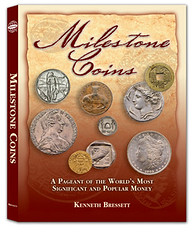 Kenneth Bressett is a numismatic alchemist, of sorts. Like few other writers today, he can spin historical facts and figures into literary gold—engaging, romantic, adventurous tales that spark the imagination and bring coins to life.
Kenneth Bressett is a numismatic alchemist, of sorts. Like few other writers today, he can spin historical facts and figures into literary gold—engaging, romantic, adventurous tales that spark the imagination and bring coins to life.
In chapter 9 of his award-winning book, Milestone Coins: A Pageant of the World’s Most Significant and Popular Money, Ken tells the story of “The Alchemist”—Nicaraguan revolutionary general Agusto César Sandino, who managed, after a fashion, to turn lead coins into gold, with tragic results.
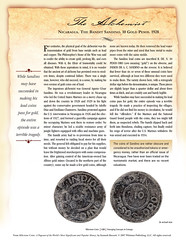 “For centuries,” Ken writes, “the physical goal of the alchemist was the transmutation of gold from base metals such as lead and copper. The Philosopher’s Stone of the Wise was said to confer the ability to create gold, prolong life, and cure all diseases. With it, the Elixir of Immortality could be obtained. With these aspirations in mind, it is no wonder that the ancient art of alchemy has persisted even to modern times, despite continual failure. There was a single man, however, who did succeed, in a sense, by making his own version of gold coins out of lead. The ingenious alchemist was General Agusto César Sandino.”
“For centuries,” Ken writes, “the physical goal of the alchemist was the transmutation of gold from base metals such as lead and copper. The Philosopher’s Stone of the Wise was said to confer the ability to create gold, prolong life, and cure all diseases. With it, the Elixir of Immortality could be obtained. With these aspirations in mind, it is no wonder that the ancient art of alchemy has persisted even to modern times, despite continual failure. There was a single man, however, who did succeed, in a sense, by making his own version of gold coins out of lead. The ingenious alchemist was General Agusto César Sandino.”
I’m pasting the text of the rest of “The Alchemist.” This is one of more than 100 numismatic tapestries Ken weaves in Milestone Coins.
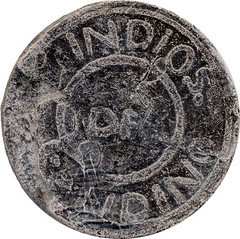
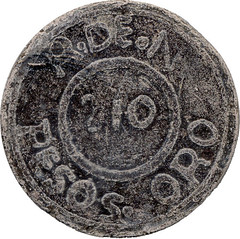
For centuries, the physical goal of the alchemist was the transmutation of gold from base metals such as lead and copper. The Philosopher’s Stone of the Wise was said to confer the ability to create gold, prolong life, and cure all diseases. With it, the Elixir of Immortality could be obtained. With these aspirations in mind, it is no wonder that the ancient art of alchemy has persisted even to modern times, despite continual failure. There was a single man, however, who did succeed, in a sense, by making his own version of gold coins out of lead.
The ingenious alchemist was General Agusto César Sandino. He was a revolutionary leader in Nicaragua who led the United States Marines on a merry chase up and down the country in 1928 and 1929 in his fight against the conservative government headed by Adolfo Díaz and Emiliano Chamorro. Sandino protested against the U.S. intervention in Nicaragua in 1926 and the elections of 1927, and formed a guerrilla campaign against the occupying Marines sent there to restore order. No minor character, he led a sizable resistance army of jungle fighters equipped with rifles and machine guns.
The bandit army had to re-provision from time to time, and resorted to raiding local stores for all their needs. The general felt obligated to pay for his supplies, but without money he decided on a plan that would leave the frightened storekeepers with some compensation. After gaining control of the American-owned San Albino gold mines (located in the northern part of the country), some say he made a few gold coins, although none are known today. He then removed the lead water pipes from the mine and used that base metal to make more coins with the same molds.
The Sandino lead coins are inscribed R. DE. N. 10 PESOS ORO (oro meaning “gold”) on the obverse, and INDIOS DE A. C. SANDINO on the reverse. It is believed that fewer than six or seven of these unusual coins have survived, although at least two different dies were used to make them. The variety shown here, with a retrograde dollar sign before the denomination, is unique. These pieces are slightly larger than a quarter dollar and about three times as thick, and are crudely cast and barely legible.
While Sandino may have succeeded in making his lead coins pass for gold, the entire episode was a terrible tragedy. He made a practice of inspecting the villages, and if he did not find his money in circulation, he would kill the “offenders.” If the Marines and the National Guard found people with the coins, they too might kill them, as suspected rebels. The bandit slipped back and forth into Honduras and was never captured, but finally ended his reign of terror after the U.S. Marines withdrew. He was seized and executed in 1934.
The coins of Sandino are rather obscure and considered to be unauthorized tokens or emergency money, rather than an official issue of Nicaragua. Few have ever been traded on the numismatic market, and there are no recent valuations.
To read the earlier E-Sylum article, see: MORE ON THE ALCHEMICAL MEDALLION (www.coinbooks.org/esylum_v13n52a12.html)
DICK JOHNSON: WILL 2011 BE THE YEAR WE LOSE THE CENT?
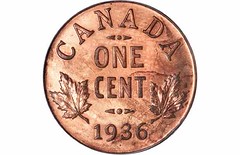 Canadians, it appears, are more intelligent than Americans. In viewing, at least, the solution to the rising cost of minting a cent coin and its drastically declining value in purchasing power as a circulating coin. The majority of Canadians want to stop using their cent coin. It can still remain a money of account, as all prices remain in cents. It is only the final transaction amount -- Canadians colorfully call this the "tally amount" that will be rounded off to the nearest five cents -- the lowest coin still to circulate.
Canadians, it appears, are more intelligent than Americans. In viewing, at least, the solution to the rising cost of minting a cent coin and its drastically declining value in purchasing power as a circulating coin. The majority of Canadians want to stop using their cent coin. It can still remain a money of account, as all prices remain in cents. It is only the final transaction amount -- Canadians colorfully call this the "tally amount" that will be rounded off to the nearest five cents -- the lowest coin still to circulate.
In a recent poll -- the Angus Reid poll -- 55 per cent of Canadians are ready to "put a nail in the penny's coffin." This mirrors a legislative report earlier last year that recommended abolishing the cent. Only 15 percent think it should be retained. Looks like 2011 will be the last year the Canadian Royal Mint will strike the least useful coin.
Why can't the United States emulate the Canadians in this wise decision? In the latest move the 110th Congress ordered the Treasury Department to find a new composition to make the American cent. Cardboard coins anyone?
The Congressional order came as a result of an American poll that revealed more Americans want to retain the cent. For nostalgia mostly, but for a few other reasons as well: for incidental charity donations, for the belief that rounding off increases prices, and for the very strong zinc industry lobby wishing to retain supplying the copper coated zinc blanks shipped to the mints for striking the low value coin. The Congress action is following, not leading, that's not good management.
Wake up America! That nostalgia is costing you millions of dollars every year. Charities should recognize their incidental donations would increase if the lowest coin available is greater than one cent. A university study revealed the increase cost by rounding off the price at the cash register for an average family is less than a dollar a year. And the zinc industry should lobby to make a higher denomination blank than one cent -- the buggy whip of the 21st century.
Coin collectors who feel the loss of the cent coin would lessen the number of coins to collect need only look at the U.S. Mint's recent marketing of the increasing number of coins issued in recent years. Or the Mint could continue striking the cent just for collectors, like Great Britain has struck the silver one penny for Maundy Coins for centuries. Don't think the Mint will abandon the popularity of the Lincoln cent if they can still market some form to collectors.
Lincoln collectors who feel their idol will be slighted, perhaps fade into oblivion need only to look at the recent increased interest in Lincoln, as exemplified by Fred Reed's blockbuster book on Lincoln. My own firm, Signature Art Medals, is pledged to issue a new Lincoln medal every year. Three of these have already been created and issued. And you should see what is in the pipeline! Look for a stunning Lincoln Inauguration Sesquicentennial Medal in March.
Collectors will not be disappointed if the Lincoln Cent is abolished.
The time is ripe, as Canadians cut the cord on the cent, for the American Treasury to do likewise. Stop minting cents. Listen to the chief economist at the Chicago Federal Reserve Bank, Françoise Velde. He wrote the book on low value coins throughout history and around the world. He recommends "rebasing" the cent. By fiat, order every cent to be revalued to five cents. This eliminates recalling, remelting, and recoining all those cent coins. They remain in active circulation serving their intended purpose. That's intelligent!
Or, as I have proposed: Rebase both the cent and the nickel to ten cents at the same time. Who would benefit from that windfall of revaluation? Savers, penny savers! Coin collectors. Retail stores with a stock of cents and nickels on hand. And banks, also with an inventory of low value coins. All great candidates for a little monetary windfall!
Banks, perhaps most of all, from the beating they have taken from the policies of the 110th Congress in the last two years. Perhaps the new Congress will have a little more collective intelligence.
For a report on the Canadian poll click on:
More than half of Canadians want to see the penny gone
(www.news1130.com/news/local/article/163062--
more-than-half-of-canadians-want-to-see-the-penny-gone)
Or for more on that Angus Reid poll:
Half of Canadians Ready to Wave Goodbye to the Penny
(www.angus-reid.com/polls/43710/half-of-canadians
-ready-to-wave-goodbye-to-the-penny/)
BILL BURD: DOES MELTING CENTS MAKE SENSE?
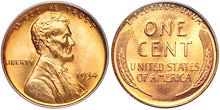 I thought this might be of interest since there have been several discussions in The E-Sylum about the cent and its copper value.
I thought this might be of interest since there have been several discussions in The E-Sylum about the cent and its copper value.
When copper reached $3.00 a pound I started hearing comments from some of my customers about making money melting cents. So I started doing the math. As a starting point I am assuming it is legal to melt cents and copper is $4.00 a pound and the smelter is paying 80% of the spot price of copper. And, in order to make it worth while we want to receive a check from the smelter for $500.00.
A copper cent weights 3.11 grams and is 95% pure copper. 154 cents equals one pound of pure copper. Cents from 1909 thru 1958 trade in the numismatic community for approximately 3.5 cents each which is more than their melt value. Cents from 1959 thru mid 1982 are copper and would be the only candidates for melting.
With copper valued at $4.00 a pound one cent contains 2.6 cents worth of copper. At 80% the value is 2.08 cents. In order to receive the $500.00 from the smelter you need to deliver 24,000 cents which is 160 lbs. Where do you get these coins? You pick them up at your bank. Since 1959 approximately 152 trillion copper cents were produced and 300 trillion zinc cents were produced. If they were evenly represented in the coins you pick up at the bank 34% would be copper.
In order to find your 24,000 pieces you need to sort through 70,600 cents which would be approximately 480 lbs. (Zinc cents weigh 2.5 grams). If you look at 100 coins per minute it would take you 12 hours to sort them. You now have 160 lbs to take to the smelter and 320 lbs to return to the bank.
Now the $500.00 you receive from the smelter is not profit. The 24,000 cents cost you one cent each so your initial investment is $240.00. That leaves you with $260.00 to cover your labor, transportation and profit.
THE BOOK BAZARRE
2011 SUMMER ANA CALL FOR EXHIBITS
The ANA's 2011 Anniversary convention will be held in suburban Chicago on August 16-20, Tuesday through Saturday -- next to O'Hare airport, at the same venue as in 1991 and 1999. The ANA has some information already on their web site, including hotel information.
The Exhibits Area will be one of the highlights of the annual convention. Although there is a separate class for numismatic literature, there were no entries in 2009 at Los Angeles, and an equal number of entries in 2010 at Boston! (Okay, an NBS member did enter a VERY nice exhibit on colonials at Boston, and the side trip to the Massachusetts Historical Society was appreciated ...) The Exhibits Local Committee is looking for new, lapsed, and returning exhibitors. Send all questions to us at ANA2011Exhibits@ChicagoCoinClub.org .
The key ingredient for an exhibit is information. Think of your favorite area in numismatics. You have acquired some interesting pieces, a few stories, and have an idea of how it all goes together. All the makings of an interesting exhibit! The URL for the main ANA exhibiting page is www.money.org/Content/NavigationMenu/NumismaticEvents/ConventionExhibits/ .
Direct links to useful pages at ANA can be found on the page of the Local Exhibits Committee www.chicagocoinclub.org/events/2011/ana/lo/collector_gallery.html . and that page will be updated as more information becomes available. Exhibiting does take a commitment of time -- the exhibits must be in place by the early Tuesday afternoon opening of the convention, and the exhibits cannot be removed until very late on Saturday afternoon (when the convention closes). It is possible to use an agent for setup or takedown, but that option has been little used during the last few years. If you cannot stay all week, but do live not too far away, maybe you could make two trips -- on PNG-day (or that evening, after work) for setup, and on Saturday for the takedown.
Do not despair if you have a great idea for an exhibit but will visit for only a day or two -- have you considered speaking at the Numismatic Theatre? Each program typically starts on the hour and lasts about 30-40 minutes, and is followed with a time for questions from the audience. Send your questions to the Numismatic Theatre Local Committee at ANA2011Theatre@ChicagoCoinClub.org .
EXHIBIT: HAND-ENGRAVED CIVIL WAR SILVER COINS
I will be exhibiting non-competitively approximately ten different unique Confederate and Union hand-engraved silver coins at the FUN Tampa show. They are on 8 reales, bust halves, seated dollars and one on a silver Vatican coin of the era. All were engraved in 1864-65 and several were obviously by the same skilled engraver. They have been acquired one by one over the past 4+ decades and are so rare that John J. Ford, Jr only owned one - which is now in my collection. I am aware of one Confederate States of America piece that has so far escaped my clutches and is privately held and one other that was recently illustrated and is in the ANS.

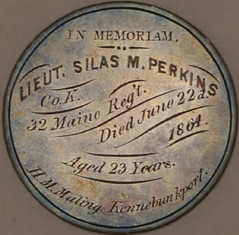
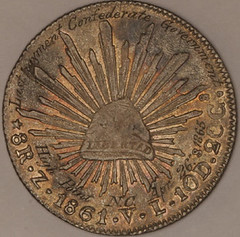
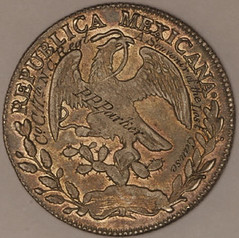
See this link: Civil War & Lincoln Medals (www.neocollect.com/coll/65/#image_viewer) p>
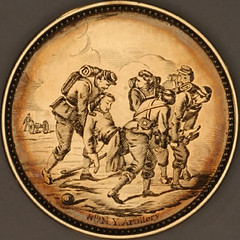
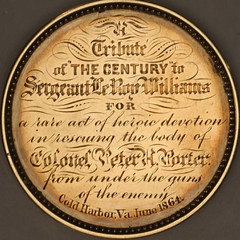
GOLD-BASED PAYMENT SYSTEM PROPOSED IN UTAH
Loren Gatch writes:
If the botched printing of its 100-dollar bills wasn't all that federal government had to contend with, now comes the state of Utah with a plan for its own, gold-backed currency. See the following article from the Salt Lake City Tribune.
Since payment in gold would be optional and not a legal tender, the plan would probably pass constitutional muster. It might also revive the private production of gold coins, which should warm all numismatists' hearts! The plan ties together two Tea Party ideas -- the issue of gold coins with the creation of a state militia, the Utah Defense Force, which would protect the state's stocks of gold bullion.
Imagine paying your next parking ticket in gold Krugerrands or renewing your driver license using American Gold Eagles.
A proposal in the Utah Legislature would require the state to allow just that, requiring government agencies to accept gold for transactions, and creating a parallel monetary policy for intrastate commerce tied to the price of gold.
Under the legislation that has been drafted, Utah residents could mint their own gold or silver coins, a storehouse would be created to stockpile the precious metal and the Utah Defense Force, an arcane state militia that may be called and armed by the governor, would be responsible for securing the inventories.
“I think it has merit,” said Rep. John Dougall, R-Highland, who had the proposal brought to him by a constituent and committed to opening a bill file. Another representative will probably end up sponsoring the legislation.
“It’s really about creating an option,” said Larry Hilton, an attorney and insurance salesman who authored the “Utah Sound Money Act” and took it to Dougall. If the dollar falters, he said, it would be beneficial to the state to have an alternative.
“It’s not intended to be compulsory in any way,” Hilton said. “The state is offering to taxpayers, ‘If you want to pay your taxes in gold or silver, we’ll accept them.’ ”
To read the complete article, see: Legislation proposes Utah adopt a gold-based system (www.sltrib.com/sltrib/home/50949183-76/gold-state-utah-coins.html.csp)
THREE TONS OF SONG DYNASTY COINS FOUND IN CHINA

An ancient kiln storing several tons of copper coins dating back to the Song Dynasty (960-1279) was excavated in Hua County of northwest China's Shaanxi Province on Dec. 22.
 The kiln is 1 meter wide at the mouth, 2 meters wide at the belly and 3 meters deep. More than 20 kinds of copper coins were found in the kiln with a total weight of 3 tons.
The kiln is 1 meter wide at the mouth, 2 meters wide at the belly and 3 meters deep. More than 20 kinds of copper coins were found in the kiln with a total weight of 3 tons.
To read the complete article, see: Ancient kiln, cache of copper coins excavated in Shaanxi (english.peopledaily.com.cn/90001/90782/7240735.html)
To view television footage, see: Coins, possibly 800 years old, found in China (abclocal.go.com/kabc/story?section=news/bizarre&id=7861447)
BANKNOTE PAINTED ON WOMAN'S BACK FOR CHARITY FUNDRAISER
 She was thought to be earning £200,000 a year fronting early morning show GMTV, so she shouldn't be short of a bit of cash.
She was thought to be earning £200,000 a year fronting early morning show GMTV, so she shouldn't be short of a bit of cash.
Nevertheless Kate Garraway was looking to raise some money when she ditched her clothes to pose nude for a provocative photoshoot. In actual fact the 43-year-old Daybreak presenter was helping to raise funds for a good cause.
Turning to face the camera, Kate covered her chest and smiled to the camera showing off a svelte figure.
The body paint which shows a five pound banknote covers her back from the top of her shoulders to the base of her spine.
And the Daybreak Entertainment presenter looks considerably younger than her years, with flawless skin, simple make-up and shiny hair.
To read the complete article, see:
You can bank on Kate Garraway to raise eyebrows: Daybreak presenter poses topless to raise cash for charity
(www.dailymail.co.uk/tvshowbiz/article-1343418
/Kate-Garraway-poses-topless-raise-money-charity.html)
CHOCOLATE COINS, ATTRIBUTED AND PRICE-CODED
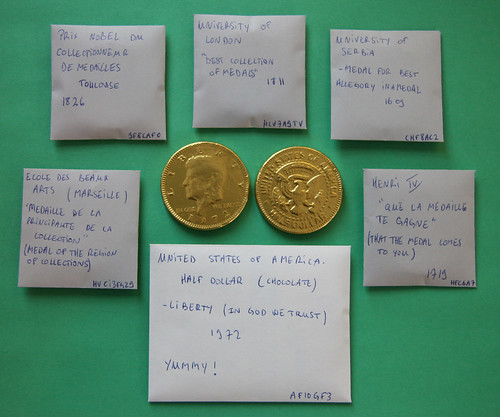
One of the most touching and sweetest – literally -- Christmas gifts that I received this year was a set of chocolate coins from my son and his girlfriend Léa, who is a university student in France.
When the two of them arrived just before the holidays, they were unusually interested in seeing some of my school medal collection. They are not collectors so this seemed a bit odd, but I jumped at the chance to show them some of my recent acquisitions and pulled out a box with some French university medals.
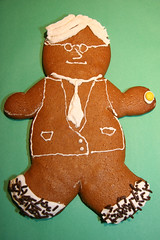 I was thinking all along that my son might finally be catching the collecting bug, but they had something else in mind. As I was showing them medals, they were taking careful mental notes of the way I wrote up the envelopes, rather than focusing on the medals themselves, so they could put together the mini collection you see here.
I was thinking all along that my son might finally be catching the collecting bug, but they had something else in mind. As I was showing them medals, they were taking careful mental notes of the way I wrote up the envelopes, rather than focusing on the medals themselves, so they could put together the mini collection you see here.
Note that Léa even put the price codes down in the lower right corner of each envelope, just like on my collection envelopes. When I unwrapped the gift box, they were very eager to know if the codes they wrote meant anything. No, but I’m assuming the French translations are correct!
They also decorated a gingerbread man to look like me, complete with a gold medal in my left hand, though my tan isn’t this good with the recent snowstorm in the northeast.
FEATURED WEB PAGE: AUSTRIAN CALENDAR MEDALS
This week's Featured Web Page is on Austrian Calendar Medals.
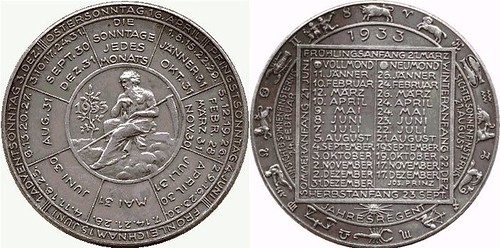
The Calendar Medals (Kalendermedaille) produced by the Austrian Mint probably had their origin in 1933. They have been minted annually ever since and are a fascinating series of medals with superb designs executed by master engravers and minters. They usually depict one of the seven planets known to ancient astrologers (in astrology the Sun and Moon are treated as planets) or by their manifestation as deities (generally Roman) or at least by a closely related theme. The reverses usually have a calendar of all the Sundays of the year as well as the dates of major holidays surrounding the calendar design. Many Calendar Medals also exist in customized versions which were created for the needs of specific Mint customers.
The subjects of the medals' designs follow a recurring seven year cycle. At the beginning of each new seven-year production cycle the subjects are re-used but with new designs. Those recurring subjects in order of appearance seem to be:
1. Sun/Sol 2. Venus 3. Mercury 4. Moon/Luna 5. Saturn 6. Jupiter 7. Mars
www.austriancoins.com/MedalsCalendarI.html

